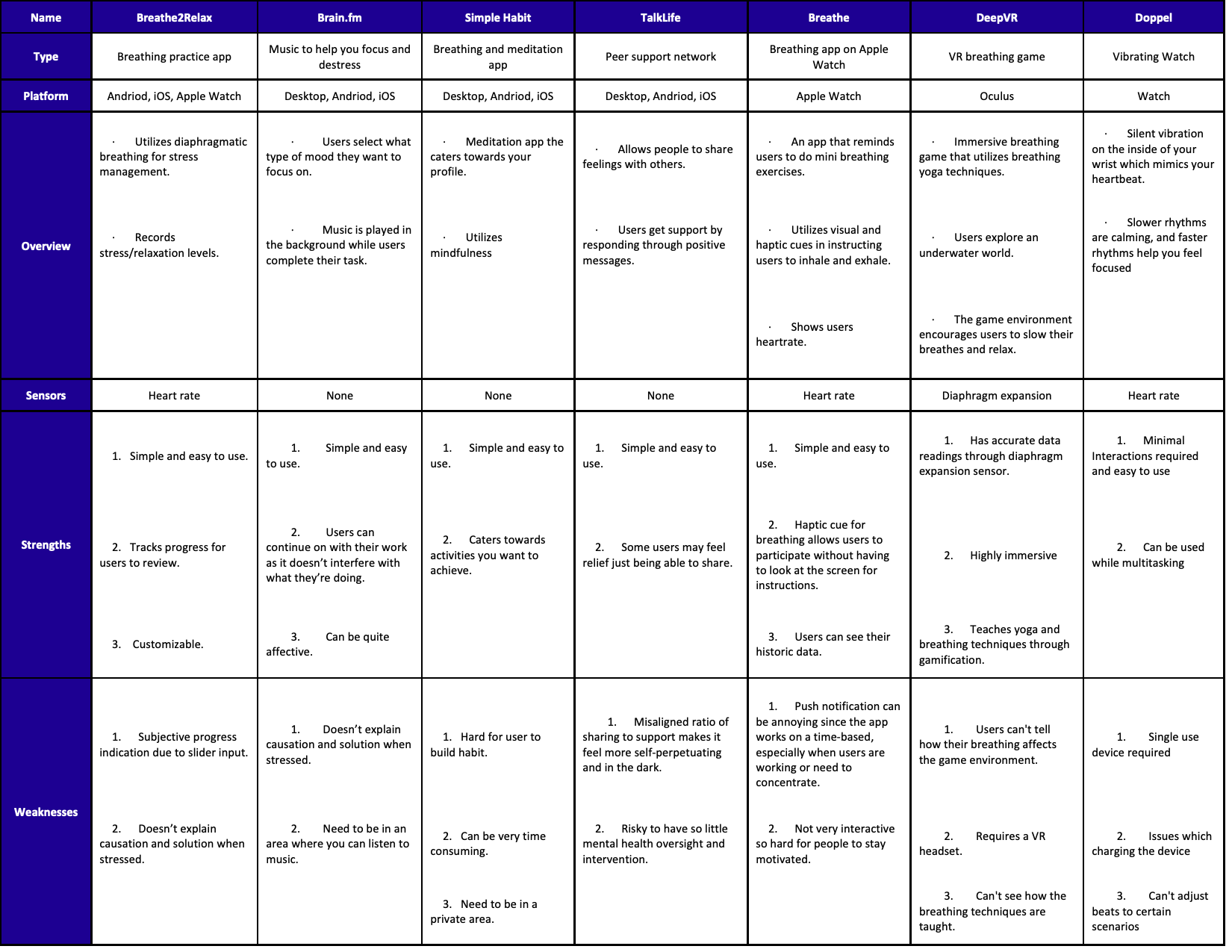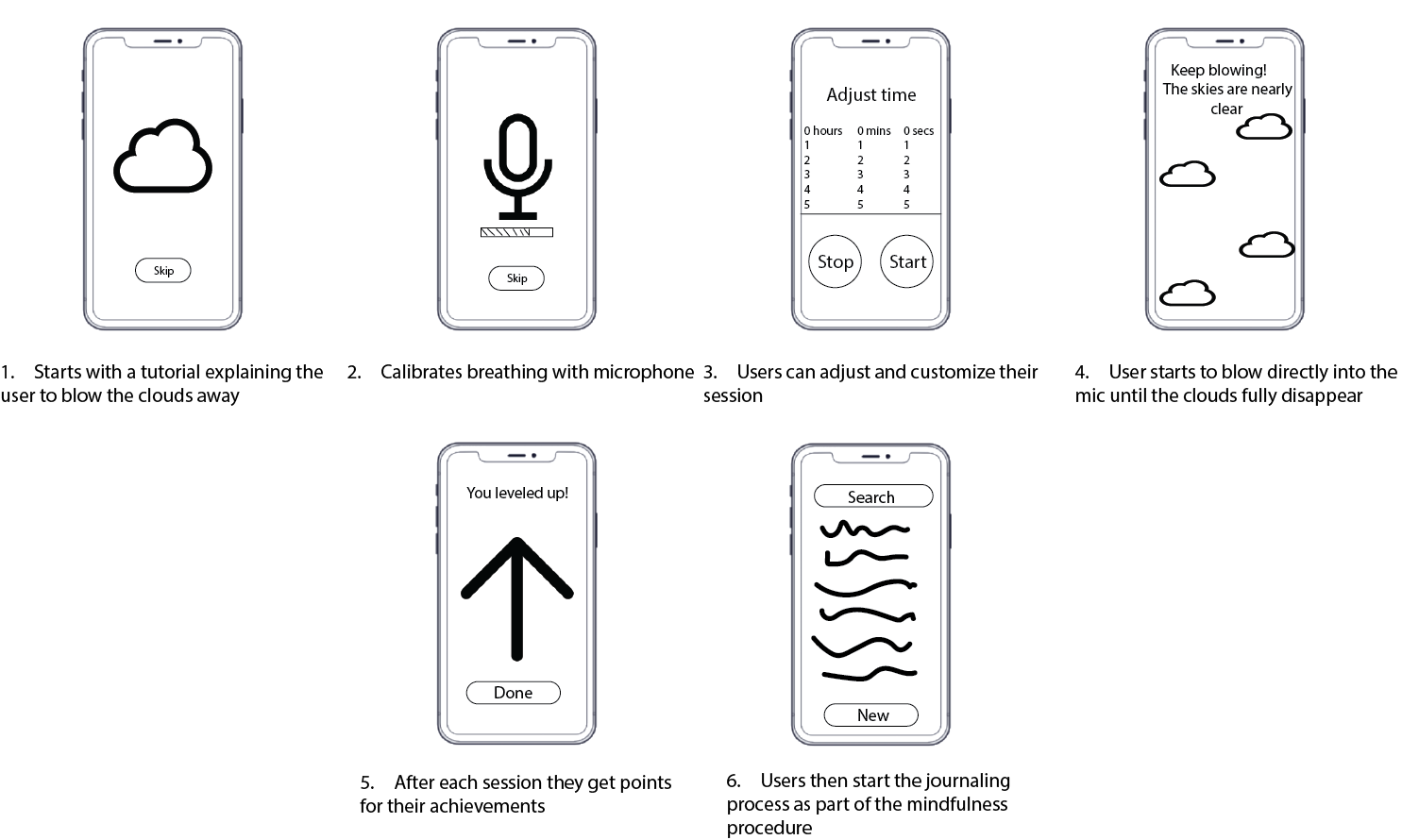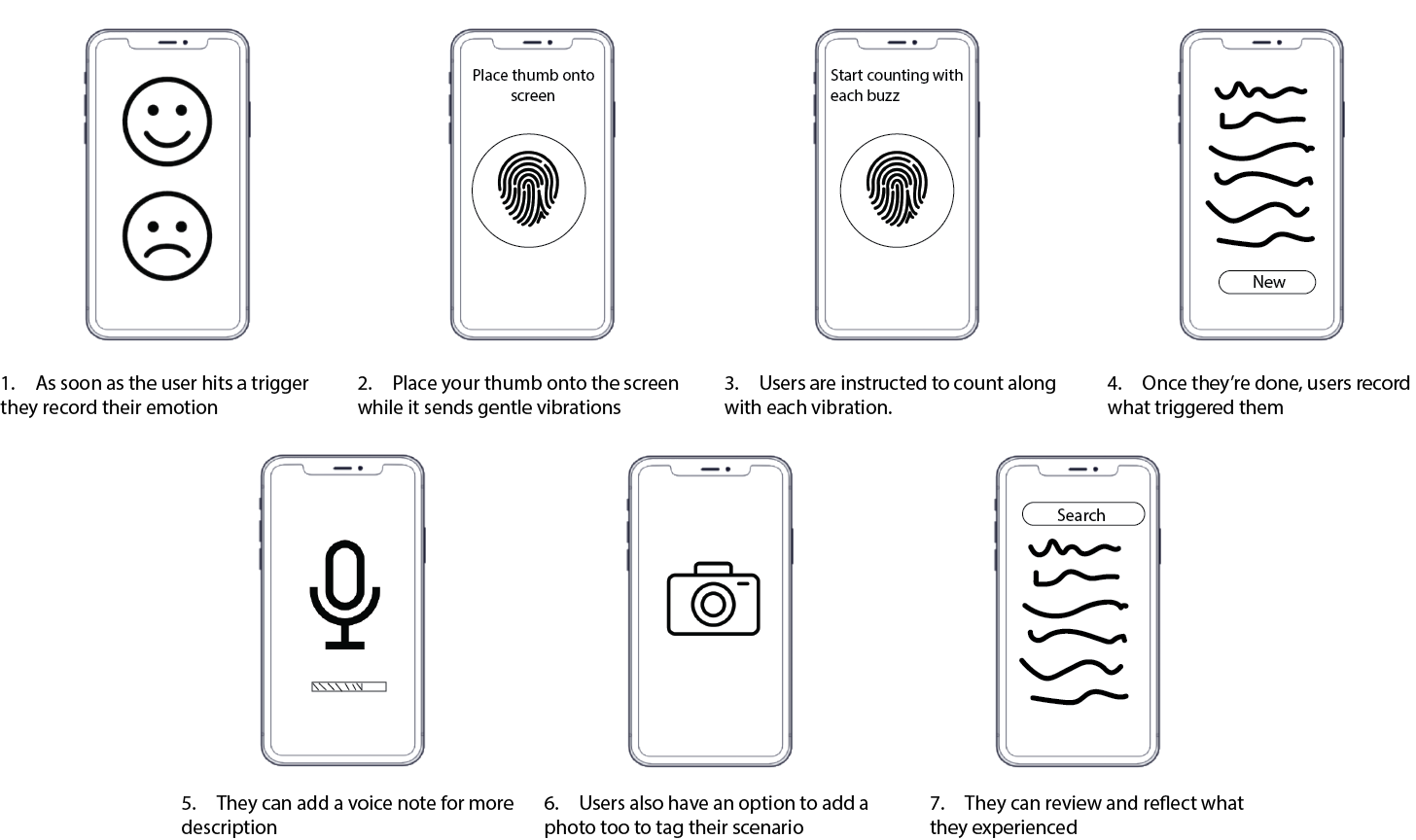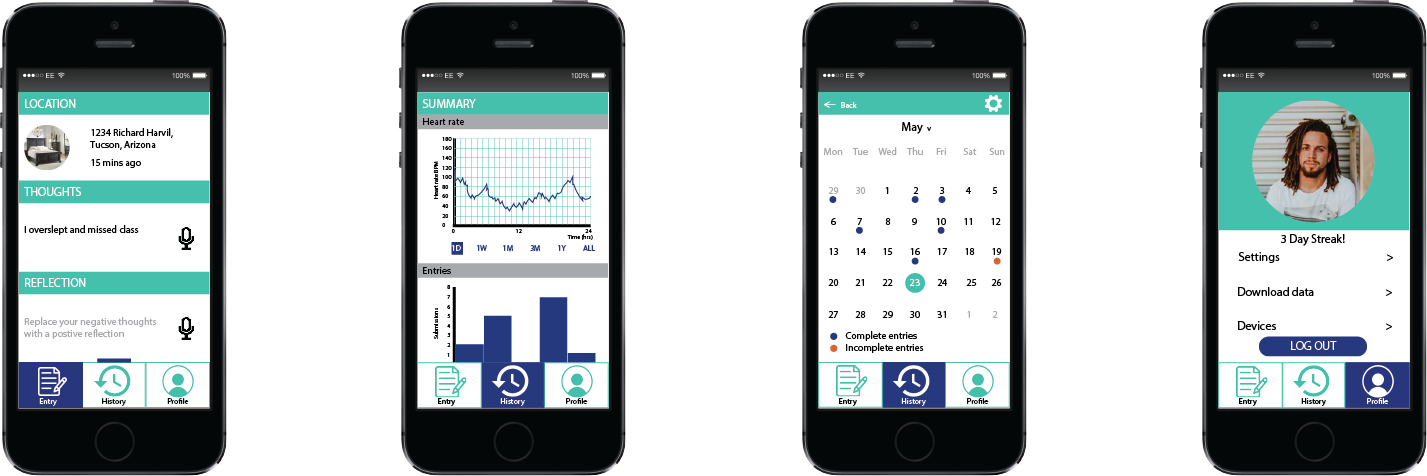
Zen
Designing an app for those struggling with stress & anxiety
Duration: 4 months
Team: 3 members (PM, SWE, and UXD/R)
Role: UX Designer and Researcher
Tools: Sketch and Principle

Executive Summary
Problem: The level of social engagement standards and workload expected from the students at the University of Arizona (U of A) leads to a high level of stress and mental health issues. Majority of the students need assistance when it comes to their mental well-being, but don't seek help because of the stigma of mental illness.
Solution: We designed a smartwatch & smartphone application that incorporates Cognitive Behavioral Therapy & Stress Regulation Exercise through calming counts, to assist those struggling with stress & anxiety by encouraging self-awareness through positive coping mechanisms.
My Contribution: As the UX Designer and Researcher on the team, I conducted all the research & design activities with the Engineer and Project Manager.

Expert Interview
To get an overview of the U of A’s student’s experience with mental health and the current intervention methods, we conducted a semi-structured interview with a mental health expert from the Counseling and Psych Services. Our expert, who had over 12 years in experience, deeply understood where the stress and anxiety for students came from, and the steps taken to improve the state of their mental health on campus. Our main take-aways were:

Literature Review
Current research of innovation for mental wellbeing has been for the most part centered around detecting symptoms. We focused on research that could center around assisting the conveyance or the enablement of users. Our findings showed that there are three prominent methods of interventions:
- Cognitive Behavioral Therapy (CBT).
- Stress Regulation Exercises.
- Positive Psychology.
Competitive Analysis
We conducted a competitive analysis of existing apps on various platforms. From the analysis, we learned that:
- There are a variety of applications that are used as sensors for measuring stress and anxiety level.
- The majority focus on regulating or monitoring, but only a few do both, and even less incorporates identifying causation and solution.
- Most have elements of immediate physical interaction as a form of intervention.
- Only a few are clinically standard treatments or tailor to one’s needs, and even less do both.


User Interviews
To learn more about our target users, we conducted several semi-structured interviews with U of A undergraduate and graduate students. Some of our main findings include:
- “Academic-life balance” was the main source of stress for most students.
- The majority felt there are points where they needed some sort of assistance, however, most didn't seek help due to the stigma.
- Some participants perform methods of stress intervention, such as meditation.
- Interactive immersive activities, such as playing video games, and exercising, help students destress.
Personas
After summarizing and analyzing the interview results, we developed the following personas to help us guide our design process. In general, both personas would have a high agreeableness as part of their O.C.E.A.N. personality trait.


Ideation
As a group, we generated a wide variety of concepts for coping with stress and anxiety, and narrowed them down based on the effectiveness of the user understanding causality, feasibility, convenience, and whether they could be adapted to work with elements of immersiveness.
We then came up with low-fidelity prototypes for our top three concepts.

Lo-fi Prototypes
Concept 1
Concept 1 is a priority list app that prompts you to set your goals for the day the first thing in the morning. It utilizes positive psychology, by sending affirmations through a virtual therapy pet that the user can customize. The purpose of this app is to teach users how to organize and visual each task they need to complete, in order to be better organized with their academic and nonacademic life. At each pain point, they receive positive affirmations as a method to relieve their stress.

Concept 2
Concept 2 utilizes stress regulation exercises through gamification. The app is a mobile breathing game where users "blow things that clouds their mind". Each session is customizable depending on the user’s requirements. Once a user completes a session, they record the details of their day as part of a mindfulness procedure for self-reflection. The purpose of this app is to immediate destress the user, while allowing them to be fully aware of what they’re doing and not overly reactive or overwhelmed by what’s going on around them.

Concept 3
Concept 3 is an app that utilizes Cognitive Behavioral Therapy and Stress Regulation Exercise through calming counts by utilizing haptic feedback. The app mimics a relaxed heartbeat by making the user count with the vibration at 40 beats per minute for 30 seconds, as one would during calming counts. Once the user finishes, they record an entry of what occurred to them through either text, audio, or taking a photo.

User Feedback
We introduced our 3 concepts to potential users at Arizona and assembled both qualitative and quantitative feedback. After presenting each concept, we requested users that they rate how frequently they'd utilize the solution, how compelling they figure it would be, and how likely they would prescribe the solution to someone. We additionally asked their top pick and least favorite part of every concept, and let them compare each other with all three concepts. Users consistently favored Concept 2 and 3 over Concept 1. Subsequently, we concentrated our analysis on looking at Concept 2 and Concept 3.
Based on user feedback, we decided to iterate and continue our process with Concept 3.

User Flow
We then mapped out our updated user flow in order to assist us in building the Hi-Fi prototype.

Hi-Fi Prototype
Smartwatch app
For our hi-fi prototype, we decided to additionally integrate the app through a smartwatch as a method to overcome the issues that users previously brought up. We felt that utilizing one’s natural relaxed heartbeat and detecting once it’s reached that level through the sensors, can aid the duration of counting the vibrations, while customizing that length. Additionally, having the watch vibrate without holding, or pressing any hardware, felt more natural than using one’s thumb. We also added elements of gamification, similar to concept 2, to keep the user immersed and motivated in utilizing the app.
Users start off by selecting a new entry or returning or to an old one. They tag their emotion depending on how they're feeling. Once done, they continue on to the calming count portion, where they count along with each vibration that is adjusted according to their normal relaxed heart rate. Once their heartrate is stabilized, they record what they experienced through a speech to text converter.

Smartphone app
Users can edit and review their entries by checking the app on their phone and attaching a photo of their setting. They can review previous entries through the calendar view, as well as historic data of their health. They have the capability of reviewing a map in understanding of where most of their issues occur too. They can adjust their notifications and settings by clicking on their profile, as well as downloading all their data.

Questionnaire
To assess our prototype, we directed a usability testing session with our potential users. Once we clarified the motivation behind the project, we recorded some personal information such as, status, level of stress, etc. After that, we gave them accompanying tasks to observe:
- Add a new entry.
- Find an incomplete entry.
- Add a reflection to an incomplete entry.
SUS Score
After analyzing their tasks, we then asked them about their experiences using the app, how often would they utilize the concept, how effective they think it is, and how likely would they suggest this to others. We additionally let them review their top pick/least favorite aspect of the system, and complete the System Usability Scale (SUS). Overall, the users liked our app and on average gave a SUS score of 83.51, which is was significantly higher than the average of 68 in comparison.
Future Direction
However, there were a few issues that we noticed and users identified. Moving forward for our next iteration we would make the following changes:
- Add various classifications of types of stress, such as exams, projects, relationships, etc., to ease the understanding of the source of the stress.
- Identifying patterns that users aren’t noticing within their sources that they're trying to get rid of.
- Having an onboarding screen that acts like a quick tutorial, explaining to the user how to use the app.
- Adding notifications to encourage and motivate users, and test if they benefit from it.
- Conduct longer testing sessions and analyze the effectiveness of the app in the long run. Unfortunately, we were only able to test our prototype for 10 minutes per session.
Surprise!
Thank you for taking the time to read through this case study! As a token of my appreciation, here's a little reward :)
